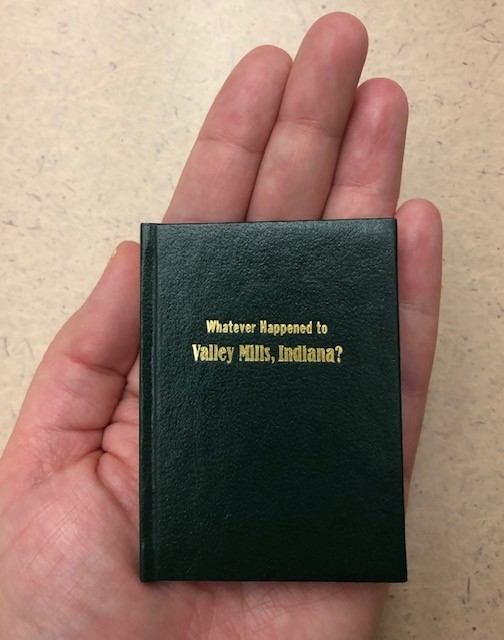
Plan your visit
From the Cataloger’s Desk: A New Miniature Book in the Collection
December 13, 2019

I recently cataloged a charming miniature book, Whatever Happened to Valley Mills, Indiana? According to the Miniature Book Society, “In the United States, a miniature book is usually considered to be one which is no more than three inches in height, width, or thickness.” This newest miniature in the collection measures in well under three inches in height and width and is only 19 pages in length. In other words, it’s quite literally short and sweet! In it, author Francis J. Weber, a self-described “old Catholic priest,” fondly shares childhood memories growing up in Valley Mills during the 1930s and 1940s. Unfortunately, as he laments, this small Indiana village no longer exists, and “all that remains … is a memory.”

Small enough to fit in the palm of your hand!
Miniature books have a long and fascinating history. However, there is some disagreement about when, exactly, they appeared. Some say ancient Sumerian clay tablets with cuneiform writing were the first. Others claim they originated in the Middle Ages with small books of hours and similar religious works. Regardless, after the advent of the printing press in the 15th century, printers began testing the limits of size, and over time, technological innovations allowed for smaller and smaller type. And why make miniature books? Historically speaking, the simplest answer is convenience – they were portable and easy to store.
No matter when or why miniature books appeared, the craftsmanship involved in assembling them demands our respect. There are many different elements at play: type, paper, illustrations, binding, etc. It takes time and enormous talent to bring them all together and create something so small, yet also readable and beautiful. To illustrate this point, our copy of Whatever Happened to Valley Mills, Indiana? is one of only 150 copies made.
I encourage you to explore our small collection (pun intended!) of miniature books at the IHS library. And don’t worry, we’ll provide the magnifying glass!









